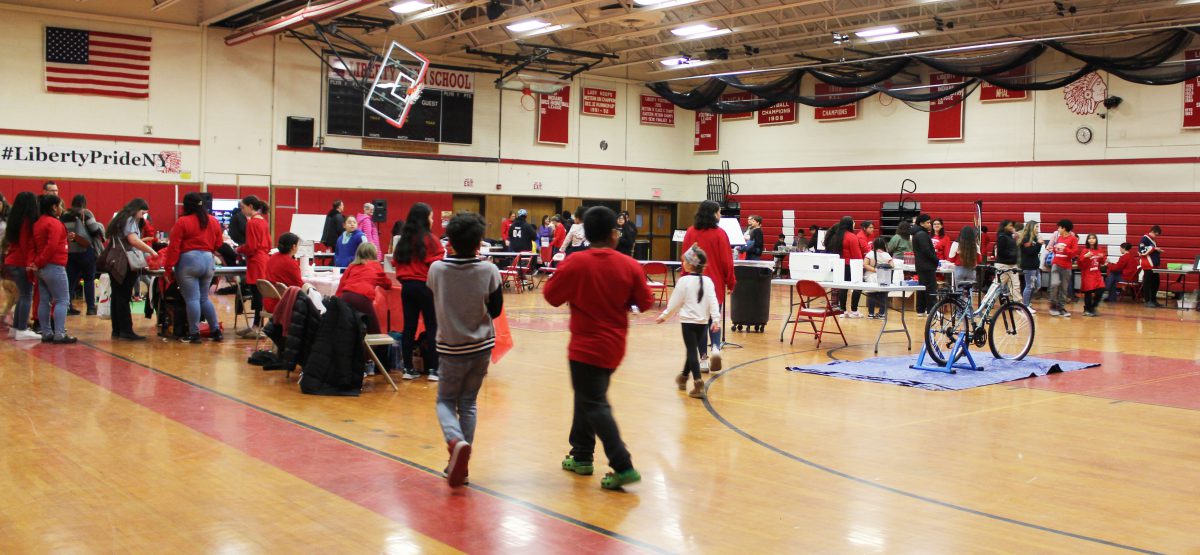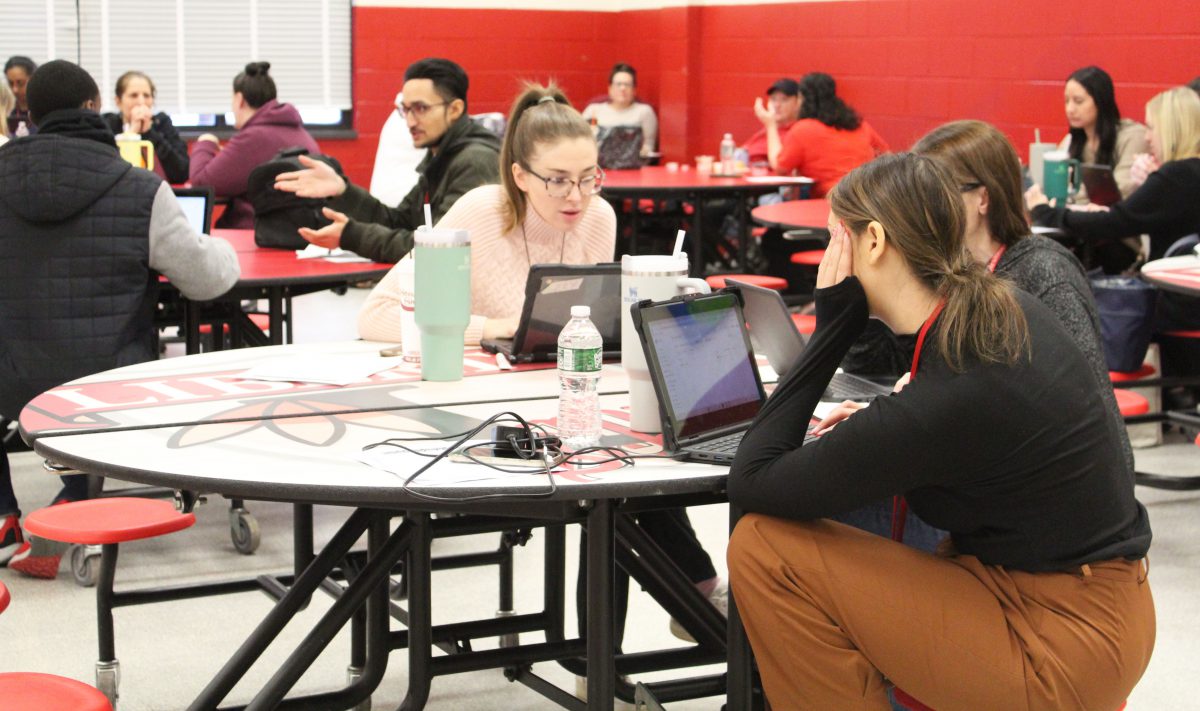Month: February 2024
Hundreds see All Things Liberty has to offer at winter festival
The Liberty High School gymnasium lobby and surrounding hallways were packed Saturday, Feb. 24, with vendors, informational booths and games to bring the community together for the inaugural All Things Liberty Winter Festival.
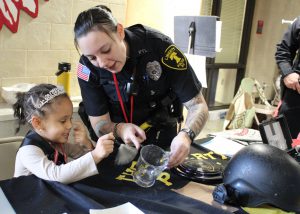 Hundreds of students, parents and guardians, as well as community members, flocked to the event, where they could play carnival-type games, sing karaoke, learn about programs and activities in the district and get information about 15 local programs and organizations. Attendees also were able to purchase wares from nearly a dozen craft vendors
Hundreds of students, parents and guardians, as well as community members, flocked to the event, where they could play carnival-type games, sing karaoke, learn about programs and activities in the district and get information about 15 local programs and organizations. Attendees also were able to purchase wares from nearly a dozen craft vendors
“I am bursting with pride to be a part of such an extraordinary community,” said Community Schools Coordinator Stacy Feasel, who organized the event. “Our exceptional teachers and staff demonstrated unwavering dedication, with many devoting not only their time on Saturday but also months of meticulous planning and organization.”
Dozens of student volunteers took part as well.
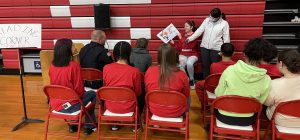 “Our student volunteers were simply outstanding, taking ownership of their roles and offering assistance wherever needed,” Feasel added.
“Our student volunteers were simply outstanding, taking ownership of their roles and offering assistance wherever needed,” Feasel added.
More than $400 in monetary and food contributions benefited the Snack Pack Program, which provides meals to families in need over weekends and breaks.
The All Things Liberty Winter Festival supports the district’s five-year strategic plan pillar of culture.
“We are proud to be able to showcase what makes Liberty — the school and community — a great place in which to learn and live,” Superintendent Dr. Patrick Sullivan said.
More photos from the event can be found on the LCSD Facebook page and LCSD Instagram page.
New technology brings history to life
Liberty Central School District sixth-graders in Samantha Abplanalp’s social studies class recently had the opportunity to interview Egyptian pharaohs.
No, they didn’t travel in a time machine. They used ChatGPT.
“The idea of using AI can be scary, but I know that students will begin using it at some point in their academic career,” Abplanalp said. “I thought it would be better to teach students how to use AI appropriately now.”
In sixth grade, students learn about early humans and ancient civilizations, from Mesopotamia to ancient Egypt, then China, Greece and Rome. Abplanalp, who has been teaching at Liberty Middle School for three years, tries to make learning fun.
Using technology is one way Abplanalp works to keep her students actively participating in class. “I find that students are much more engaged in their learning when they are doing projects and collaborating with others,” she said.
Interviewing a pharaoh
In the pharaoh project, students are creating posters using facts garnered from credible sources on the internet. Students were provided a graphic organizer to plan the poster and write the facts that they found. They created interview questions that they would ask their pharaoh if given the opportunity. This is where ChatGPT came in. Students met in small groups with Abplanalp and asked their questions to ChatGPT.
To help students get accurate answers, Abplanalp asked ChatGPT to be the pharaoh and to reword responses for sixth graders.
“I think it was interesting because it acted like Cleopatra and told me that she purposely made a snake bite her because she was worried the Egyptians were going to kill her anyway,” student Zalaina Nash said.
After asking their questions, students had to decide whether ChatGPT answered their question and if it seemed accurate. They had to use an additional source to determine whether it was correct.
“I looked the same question up on a different website and got a different response, which showed me that ChatGPT might not always be accurate, just like we talked about in class,” student Madison LaMantia said.
“Before using ChatGPT in the classroom, I always discuss with students that it can provide inaccurate information, just like other sources that can be found online,” Abplanalp said.
AI in the classroom
Students were shocked by how fast ChatGPT responded to their questions, Abplanalp said. Many students were looking forward to the interviews, and they were really excited when fact checking and finding that ChatGPT generated an accurate response, she added.
“It was a fun assignment where students got to play around with technology while also learning that AI can have errors,” Abplanalp said.
Her students had used AI previously when studying the Indus River Valley. They asked questions, and Abplanalp typed them into ChatGPT. She read the responses aloud, and the class discussed how some of the questions couldn’t be answered since archaeologists themselves were unable to answer those questions.
The program actually inspired the pharaoh activity, Abplanalp said. “When I was thinking about how ChatGPT could be used in the classroom, I played around with it to see what ideas it could give me.”
She typed in “‘How can I use ChatGPT in the classroom?” and one of the ideas generated was having it pose as a historical figure.
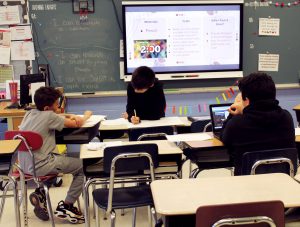 The program helped spark ideas for students as well.
The program helped spark ideas for students as well.
“I like how ChatGPT tried to figure out when Cleopatra’s birthday was, and I like how it gives you extra information. This helped in my research because it gave me more ideas of what I can put on my poster,” student Milana David-Colon said.
“I look forward to seeing how else AI can be used in the classroom,” Abplanalp said. “I know that AI is becoming a big part of the world around us and as technology continues to advance, there is no question that the use of AI will continue to grow.”
Beyond social studies
The class uses Putnam Northern Westchester BOCES curriculum, which is an integrated social studies and ELA curriculum. Abplanalp said her initial ideas come from the curriculum, and she tries to add in engaging activities.
Since the social studies curriculum integrates ELA, students spend a lot of time reading, writing and answering comprehension questions. “Sometimes students don’t even know if they are in ELA or social studies,” Abplanalp said.
The curriculum in different classes often align and work off of each other. In the spring, when students begin learning about ancient Greece in social studies, they begin reading “Percy Jackson and the Lightning Thief” by Rick Riordan in ELA. The novel discusses the Greek gods and goddesses.
“When students begin reading, the lines between social studies and ELA really blur and the kids seem to enjoy how the two blend together,“ she said.
And it is more than ELA lessons that cross over into social studies. The ChatGPT project showcases the importance of fact-checking and accuracy. Students also learn about the geography of the world, different cultures and how history impacts the world today. Students are able to see the similarities and differences between ancient civilizations and they can even compare them to our lives today.
Using aligned curriculum, explicit direct instruction and supportive teaching methods are all part of the district’s five-year strategic plan and its supporting Middle School Priority Document to improve academic outcomes.
“I often think back to when I was in social studies in elementary school. I can still remember many of the engaging activities that my teachers did in the classroom, from dressing like Greek gods and goddesses to building a replica of the Great Wall of China, I was given the opportunity to be creative while learning, and those are the lessons I will never forget,” Abplanalp said. “As a teacher, I want my students to not only retain what they learn, but to enjoy school and the learning process.”
Education goes beyond facts and figures at LES
From task-tacklers to productive problem-solvers, dozens of students are honored monthly during Liberty Elementary School’s Character Counts Awards ceremonies.
The awards grew out of LES’s commitment to the Leader in Me (LIM) framework, which began during the 2019-20 school year and empowers students with the leadership and life skills they need to thrive in the 21st century. At that time, the school had monthly “Star Student” awards, but they had no connection to core tenets of character development, LES Principal Robert England said.
The following year, in the midst of the COVID-19 pandemic, the Character Counts awards began. The awards reinforce the concepts of LIM, celebrate student efforts in those areas, educate parents and demonstrate commitment by and to staff that this is important, England said.
“At Liberty Elementary School, we’re teaching students to think about their own thinking and make conscious and strategic choices,” he said.
LIM and the Character Counts awards support Liberty’s five-year strategic plan pillar of Culture and promoting the mission and vision of the district.
Earning an award
The building toward the awards begins during the first eight days of school, during a “social emotional orientation.”
Students are introduced or reintroduced to the Eight Habits used by Leader in Me, which are based off of Stephen R. Covey’s “The Seven Habits of Highly Effective People” and related books. Those first eight days also give the students an opportunity to get to know each other, their teachers, the staff and the school building, through scavenger hunts and other hands-on activities.
Each month, classes building-wide focus on learning one of the eight habits and reinforcing the previous one. Each classroom teacher has the opportunity to select two students for the awards each month, one for each habit that was the focus that month. If a teacher feels no student meets the criteria for one or both awards, an award will not be given for that habit in that classroom.
A student can win both awards for the month, but that hasn’t happened, England said. Students can and have won more than one award in a year.
Being Involved
 Parents and guardians of that month’s winners are invited to attend the ceremonies, which are held in two parts—kindergarten, first grade and multi-age rooms, and second through fourth grades. The ceremony is also live streamed. The aim of having parents and guardians engaged with the awards is for the habits taught at school to continue and grow at home.
Parents and guardians of that month’s winners are invited to attend the ceremonies, which are held in two parts—kindergarten, first grade and multi-age rooms, and second through fourth grades. The ceremony is also live streamed. The aim of having parents and guardians engaged with the awards is for the habits taught at school to continue and grow at home.
Students, staff and families cheer loudly as each recipient’s name is read, and the winners go to the front of the gymnasium to receive their certificates as well as a small prize.
Students take a leadership role in the awards by naming the awards. They are invited to offer suggestions for fun names for each habit’s award. The suggestions are reviewed by the Culture Committee/Building Leadership Team, which narrows down the list to three or four names on which the students vote via survey.
Tying it together
This year, LES began recognizing students with perfect or near perfect attendance during the ceremony. That reinforces the first three habits, which focus on internal choices of personal responsibility, goal setting and self-management. Those who chose to be on time and in school every day or only miss one day are recognized for their dedication to making school and their learning a priority, England said.
Each student also has “Wildly Important Goals” as part of the Leader in Me. These goals, personal and academic, help students measure their progress, as do the students’ self-reflective Personal Leadership binders. In the binder they have prompts to help them think about where they are excelling and where they could improve.
“Leader in Me prompts us to be our better selves,” England said.
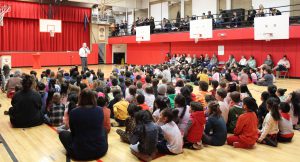 The awards also help students realize they will not always be perfect, he added. They become self aware of their failing and acknowledge they need to take steps to improve.
The awards also help students realize they will not always be perfect, he added. They become self aware of their failing and acknowledge they need to take steps to improve.
The Leader in Me principles are also reinforced by “Caught Being a Leader,” which praises students who choose to do something positive when they thought nobody was watching.
The year is capped by the Field Day in June, where the next three habits, which focus on interactions with others, are reinforced in games and activities.
Focusing on the seventh habit, “Sharpen the Saw,” (taking care of yourself), the school has replaced sugary drinks with flavored water stations, which have been a hit with students, England said.
The results
There have been positive, tangible results since Leader in Me and the Character Counts awards were established, England said.
“Our referrals have dropped dramatically,” he said.
And the curriculum integration of Leader in Me into other subjects has led to academic improvement with more students consistently reaching math and reading goals.
Students are supportive of each other, and that reinforces LIM work done in the classroom, encouraging other students to do better, he said.
“In the end, the singular purpose is for children to realize that their past or current conditions don’t need to dictate their future,” he said. “We want each and every student to have a positive vision of their futures no matter what their circumstances might be. We want our students to feel empowered with a self-directed plan, measurable goals and an internal belief that they can overcome any obstacle to meet their potential.”
Faculty, staff learn on students’ day off
Liberty Central School students didn’t have to answer the morning bell Friday, Feb. 16, but that was not the case for the faculty and staff.
It was a conference day full of learning and working to improve faculty and staff skills and knowledge to enhance their students’ classroom experience.
“It is important to offer time for our teachers to become students by offering vital professional development opportunities,” Superintendent Dr. Patrick Sullivan said.
The day started in the high school cafeteria with breakfast for all district staff.
Faculty and staff then broke into professional development sessions based on school or job description.
Elementary and middle school teachers started by working on their curriculum maps, which outlines the expectations and standards for each subject and grade level.
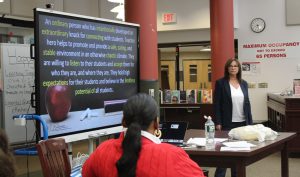
At that time, high school staff took part in a workshop with education consultant MaryAnn Brittingham, who focused on working with students who have an “I don’t care” attitude, explaining what is behind it and providing strategies to approach these students with a different mindset
Middle school staff was next for Brittingham, who addressed problems with students whose difficult home lives may impact their behavior in school. She explained methods to de-escalate situations and discussed: “What is under anger?” “Window of tolerance” and “The 3 R’s to assist in de-escalation.”
After lunch, Brittingham then spoke to elementary staff on understanding and handling attention-seeking and manipulative behaviors among students. “Utilizing and Documenting Tier 2 Behavior Interventions in the Classroom; Put the Game on the Table” aimed to help staff decipher the underlying needs behind such behavior and find ways to address them.
Brittingham finished the day working with middle school administration and student services staff on implementation of strategies and accountability measures.
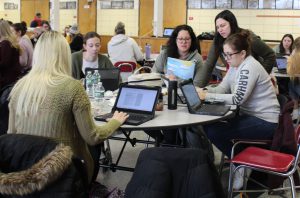
Other professional development opportunities included training for new substitutes, teacher assistants and aides, strategies for English Language Learners classrooms, using the DESSA/Aperture social and emotional screener, working with education consultants PLC Associates on Explicit Direct Instruction methods for giving transparent learning targets, breaking down complex concepts and setting up clear instructions for learning and more.
LCSD holds regular conference days to offer faculty and staff professional development in support of the five-year strategic plan. The sessions cover all pillars of the plan — curriculum, coherence, culture and MTSS, or Multi-Tier System of Supports.
LCSD seeks input on use of ARP-ESSER funds
Liberty Central School District is gathering input from the community regarding the district’s use of the American Rescue Plan Elementary and Secondary School Emergency Relief (ARP-ESSER) funding. To review how LCSD allocated the funds, visit the LCSD ARP-ESSER plan webpage.
LCSD residents and staff are asked to take this quick, anonymous survey to offer their feedback.
LES students complete winter reading challenge at Liberty Library
 Ten Liberty Elementary Students completed the Winter Reading Challenge at the Liberty Library and earned their tickets to make a “Build a Buddy,” a stuffed polar bear, on Feb. 3.
Ten Liberty Elementary Students completed the Winter Reading Challenge at the Liberty Library and earned their tickets to make a “Build a Buddy,” a stuffed polar bear, on Feb. 3.
To complete the challenge, students had to read 20 picture books by themselves or with a grown-up’s help, or read four chapter books by themselves between Dec. 18 and Jan. 31.
Congratulations to Athena Dailey, Parker Gissentaner, Kyra Magie, Anastasia Honcharenko, Sevyn Straker, Nova Keating, Lillian Keating, Emily Marques, Jayden Thomas and James Crandall.
Liberty student photographers earn honors at regional event
Liberty High School student photographers were honored Friday, Feb. 2, for their award-winning work at the Mid Hudson Region Scholastic Art & Writing Awards ceremony at SUNY New Paltz.
Liberty photo students and Liberty Photo Club members earned eight Gold Keys,14 Silver Keys and 18 Honorable Mentions. The ceremony was followed by the opening of the show containing all Key winners’ work. Seven of Liberty’s Key winners were able to attend the ceremony.
Gold Key winners, the top 5% of all photographs, were Kaitlyn Bodolosky, who won two, and Endya Alvarez, Maria Quintanilla Bonilla, Joaquin Isler Diaz, Allison Vasko, Leonel Malaga Ventura and Rachel Yaun, who each won one.
Silver Key winners, the top 10%, were Leonel Malaga Ventura with four, Jill Baumander, Kaitlyn Bodolosky, Allison Vasko and Rachel Yaun, each with two, and Endya Alvarez and Giovanni Flores Leon each with one.
Honorable mentions, top 11% and 12%, were awarded to Leonel Malaga Ventura with four, Joaquin Isler Diaz, Madelline Kelly and Rachel Yaun, each with three, Allison Vasko with two, and Endya Alvarez, Kaitlyn Bodolosky and Maria Quintanilla Bonilla, each with one.
LMS band to join Pennsylvania bands in exhibition concert
The Liberty Middle School Band will travel to Pennsylvania on Tuesday, Feb. 6, to join with the Western Wayne Middle School and Western Wayne High School for a one-of-a-kind clinic and exhibition concert sponsored by the KHS America Academic Alliance.
After working on the festival music in their own schools, band students from the two districts will meet for the first time as a band early in the morning and spend the day getting to know one another through music. Under the baton of clinician Dr. Peter L. Boonshaft, the students will have the opportunity to collaborate and learn festival rehearsal techniques to take back to their schools.
Boonshaft, director of education for KHS America, is the author of “Teaching Music with Passion, Teaching Music with Purpose, and Teaching Music with Promise.” He was honored
by the National Association for Music Education and Music For All as the first recipient of the “George M. Parks Award for Leadership in Music Education,” and was selected for the Center for Scholarly Research and Academic Excellence at Hofstra University in Hempstead, New York, where is professor emeritus of music.
The culminating exhibition concert is free and open to the public. The concert will begin at 4 p.m. at Western Wayne High School Veterans Memorial Auditorium, at 1970 Easton Turnpike, Lake Ariel, Pennsylvania. Doors will open at 3:30 p.m.
For more information on KHS America and the Academic Alliance, visit https://academicalliance.com/


